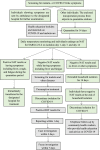Implementation and challenges to preventing the re-establishment of malaria in China in the COVID-19 era
- PMID: 35729642
- PMCID: PMC9210339
- DOI: 10.1186/s12992-022-00858-w
Implementation and challenges to preventing the re-establishment of malaria in China in the COVID-19 era
Abstract
Background: The rapid emergence and global spread of COVID-19 have caused substantial global disruptions that have impacted malaria programs worldwide. Innovative strategies to enable countries aiming to eliminate malaria as well as those that are already certified as malaria-free, are needed to address malaria importation in the context of the COVID-19 pandemic. China was certified as malaria-free in 2021 and now aims to prevent the malaria re-establishment. Nonpharmaceutical interventions such as entry screening, quarantining, and health education for individuals returning from international travel during the COVID-19 pandemic present both opportunities and challenges to the management of imported malaria. This study aimed to describe and analyze the operational challenges associated with an integrated surveillance and case management program in which malaria re-establishment prevention measures were incorporated into the COVID-19 program in China.
Methods: After the integration of malaria re-establishment prevention activities into the COVID-19 program for 10 months in Jiangsu Province, China, a focus-group discussion of public health workers working on preventing malaria re-establishment and controlling COVID-19 was held in June 2021, aiming to explore the operational challenges and lessons learned from the integrated approach.
Results: From 01 August 2020 to 31 May 2021, 8,947 overseas travelers with Yangzhou as the final destination underwent 14-day managed quarantine and 14-day home isolation. Of these travelers, 5,562 were from malaria-endemic regions. A total of 26,026 education booklets and materials were distributed to expand malaria-related knowledge. Twenty-two patients with unknown fever were screened for malaria with rapid diagnostic tests, and one patient was confirmed to have imported malaria. The challenges associated with the implementation of the integrated malaria surveillance and case management program include neglect of malaria due to COVID-19, lack of a standard operating procedure for malaria screening, mobility of public health providers, and difficulties in respecting the timeline of the "1-3-7" surveillance strategy.
Conclusions: China's experience highlights the feasibility of integrated case surveillance and management of existing infectious diseases and new emerging infections. It also demonstrates the importance of a sound public health infrastructure with adequate, trained field staff for screening, testing, contact tracing, and providing health education, all of which are crucial for the success of both malaria re-establishment prevention program and the effective control of COVID-19.
Keywords: COVID-19; Imported malaria; Integrated health program; Malaria elimination; Prevention of re-establishment.
© 2022. The Author(s).
Conflict of interest statement
The authors declare that there they have no competing interests.
Figures





References
-
- WHO: World Malaria Report 2020–20 years of global progress & challenges. In.: World Malaria Report; 2020.
-
- WHO: The potential impact of health service disruptions on the burden of malaria: a modelling analysis for countries in sub-Saharan Africa. In. Geneva, Switzerland; 2020.
-
- WHO: Global technical strategy for malaria 2016–2030. In. Geneva: World Health Organization; 2015.
Publication types
MeSH terms
LinkOut - more resources
Full Text Sources
Medical

